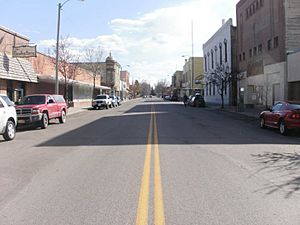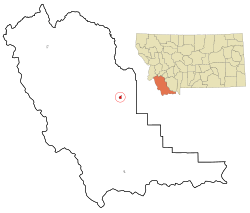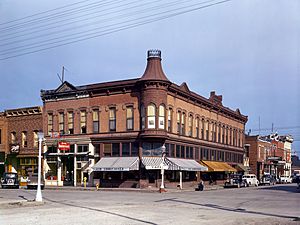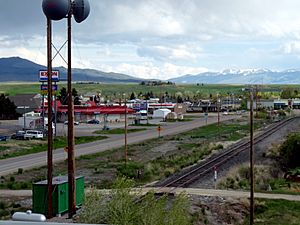Dillon, Montana facts for kids
Quick facts for kids
Dillon
|
|
|---|---|

Business District of Dillon
|
|

Location of Dillon, Montana
|
|
| Country | United States |
| State | Montana |
| County | Beaverhead |
| Area | |
| • Total | 1.90 sq mi (4.92 km2) |
| • Land | 1.90 sq mi (4.92 km2) |
| • Water | 0.00 sq mi (0.00 km2) |
| Elevation | 5,240 ft (1,600 m) |
| Population
(2020)
|
|
| • Total | 3,880 |
| • Density | 2,044.26/sq mi (789.25/km2) |
| Time zone | UTC−7 (Mountain (MST)) |
| • Summer (DST) | UTC−6 (MDT) |
| ZIP code |
59725
|
| Area code(s) | 406 |
| FIPS code | 30-20800 |
| GNIS feature ID | 0770653 |
| Website | www.dillonmt.org |
Dillon is a city in Montana, United States. It is the main town of Beaverhead County. In 2020, about 3,880 people lived there. The city was named after Sidney Dillon, who was the president of the Union Pacific Railroad.
Contents
History
Dillon started as a railroad town in 1880 in the Beaverhead Valley. It was first called "Terminus" because it was the end of the Utah and Northern Railway line for a while. In 1881, it was renamed Dillon, honoring Sidney Dillon. He helped bring the railroad through to Butte, Montana. The railroad chose this spot because it was close to gold mines.
Silver was the first metal found in the Dillon area. Gold was discovered at Grasshopper Creek in 1862. This brought many people to the area. The last big gold rush near Dillon was in 1920 and lasted for 30 years.
Dillon was important for moving goods to nearby mining towns. These towns included Bannack, Argenta, Glen, and Virginia City. In 1881, Dillon fought with Bannack to become the county seat of Beaverhead County. The first brick building in Dillon was built in 1882. Dillon became an official town in 1884. It then started building sidewalks and homes for its residents.
Many gold mining towns disappeared, but Dillon kept growing. This was thanks to the railroad and talc mining. A cattle industry began in 1865. Sheep ranching started in 1869 in the rich Beaverhead Valley. Dillon was once Montana's biggest exporter of sheep wool.
The Montana Normal College opened in 1892. It was a college for training teachers. Today, it is still open and known for its education programs. A circus elephant named Old Pitt was struck by lightning in 1943. It is buried at the Dillon fairgrounds. Captain Joel Rude of the Montana National Guard died in 1979. His F-106 jet crashed into a grain elevator during a parade. There is a plaque in his honor in Dillon.
Geography
Dillon is located at 45°12′57″N 112°38′3″W / 45.21583°N 112.63417°W. It is about 40 miles (64 km) east of the Continental Divide. The city is 5,102 feet (1,555 m) above sea level.
The United States Census Bureau says Dillon covers 1.76 square miles (4.56 km2) of land. There is no water area. Dillon is located on the Beaverhead River.
Demographics
| Historical population | |||
|---|---|---|---|
| Census | Pop. | %± | |
| 1890 | 1,012 | — | |
| 1900 | 1,530 | 51.2% | |
| 1910 | 1,835 | 19.9% | |
| 1920 | 2,701 | 47.2% | |
| 1930 | 2,422 | −10.3% | |
| 1940 | 3,014 | 24.4% | |
| 1950 | 3,268 | 8.4% | |
| 1960 | 3,690 | 12.9% | |
| 1970 | 4,548 | 23.3% | |
| 1980 | 3,976 | −12.6% | |
| 1990 | 3,991 | 0.4% | |
| 2000 | 3,752 | −6.0% | |
| 2010 | 4,134 | 10.2% | |
| 2020 | 3,880 | −6.1% | |
| U.S. Decennial Census | |||
In April 2010, Forbes magazine called Dillon one of "America's Prettiest Towns."
2010 census
In 2010, Dillon had 4,134 people. There were 1,774 households, and 897 families. The city had about 2,349 people per square mile (907 per km2). Most residents (94.7%) were White. About 1.4% were Native American. People of Hispanic or Latino background made up 3.5% of the population.
The average age in Dillon was 33.9 years. About 20% of residents were under 18. Around 19.4% were between 18 and 24 years old.
Media
Dillon has local radio stations like KDBM AM 1490 and KBEV-FM 98.3. The University of Montana also runs two radio stations: KDWG FM 90.9 and KUMW (public radio).
Television channels come from Butte and Denver. These include KXLF (Channel 4), which is a CBS station, and KTVM (Channel 6), an NBC station. KDVR (Channel 5) is a Fox station. KUSM (Channel 9) is a PBS station.
Dillon has two main newspapers:
- The Dillonite Daily shares local news, job listings, and upcoming events.
- The Dillon Tribune covers sports, community news, and weather.
Education
Dillon is part of School District 10. The schools include Parkview Elementary School and Dillon Middle School. Dillon is also home to Beaverhead County High School. In 2017, about 320 students attended the high school. Their mascot is the Beaver.
Dillon is well-known for its success in high school sports. The boys' basketball team won the state championship in 1990. Since 2000, the high school football team has won eight state championships. The boys' basketball team has won five state championships since 2007.
The city also has the University of Montana Western. In 2016, it had 1,501 students. The college mascot is the Bulldog.
The Dillon Public Library was built in 1901 as a Carnegie library. It still serves the community today.
Economy
Dillon's biggest employers are Barretts Minerals Inc., Barrett Hospital and HealthCare, and Beaverhead County. Great Harvest Bread Company has its main office for franchising in Dillon.
You can visit the Beaverhead County Museum in Dillon. Other public places include the Dillon Public Library and Barrett's Park. The YMCA also has a location in the city.
Many fun activities bring visitors to Dillon. These include fishing on the Beaverhead River, snowmobiling, and hiking. People also enjoy shopping at the Patagonia outlet. Other popular events are the annual Demolition Derby and skiing at Maverick Mountain Ski Area. Bannack State Park is also a popular spot for tourists. Dillon also hosts "Montana's Biggest Weekend" every year. This event includes the Jaycee Labor Day Rodeo, a concert, and a parade.
Infrastructure
Dillon Airport is an airport owned by the county. It is located five miles (8 km) northeast of Dillon.
Climate
Dillon has a semi-arid climate. This means it has cold, dry winters and hot, wetter summers. On January 13, 2024, Dillon had a record low temperature of −42 °F (−41 °C).
| Climate data for Dillon, Montana (University of Montana Western), 1991–2020 normals, extremes 1895–present | |||||||||||||
|---|---|---|---|---|---|---|---|---|---|---|---|---|---|
| Month | Jan | Feb | Mar | Apr | May | Jun | Jul | Aug | Sep | Oct | Nov | Dec | Year |
| Record high °F (°C) | 60 (16) |
65 (18) |
74 (23) |
84 (29) |
91 (33) |
98 (37) |
102 (39) |
100 (38) |
94 (34) |
86 (30) |
79 (26) |
65 (18) |
102 (39) |
| Mean maximum °F (°C) | 49.2 (9.6) |
52.4 (11.3) |
63.7 (17.6) |
73.0 (22.8) |
81.4 (27.4) |
88.5 (31.4) |
93.8 (34.3) |
92.0 (33.3) |
87.1 (30.6) |
75.8 (24.3) |
61.2 (16.2) |
48.5 (9.2) |
94.6 (34.8) |
| Mean daily maximum °F (°C) | 33.3 (0.7) |
36.7 (2.6) |
45.9 (7.7) |
54.3 (12.4) |
64.4 (18.0) |
72.8 (22.7) |
82.9 (28.3) |
80.9 (27.2) |
70.8 (21.6) |
56.4 (13.6) |
41.3 (5.2) |
31.6 (−0.2) |
55.9 (13.3) |
| Daily mean °F (°C) | 23.9 (−4.5) |
26.3 (−3.2) |
34.2 (1.2) |
41.3 (5.2) |
50.3 (10.2) |
57.5 (14.2) |
65.2 (18.4) |
63.2 (17.3) |
55.1 (12.8) |
43.3 (6.3) |
31.1 (−0.5) |
22.4 (−5.3) |
42.8 (6.0) |
| Mean daily minimum °F (°C) | 14.5 (−9.7) |
15.8 (−9.0) |
22.5 (−5.3) |
28.4 (−2.0) |
36.1 (2.3) |
42.2 (5.7) |
47.6 (8.7) |
45.5 (7.5) |
39.3 (4.1) |
30.3 (−0.9) |
21.0 (−6.1) |
13.2 (−10.4) |
29.7 (−1.3) |
| Mean minimum °F (°C) | −11.0 (−23.9) |
−5.8 (−21.0) |
3.3 (−15.9) |
15.6 (−9.1) |
23.5 (−4.7) |
32.1 (0.1) |
38.9 (3.8) |
36.6 (2.6) |
26.4 (−3.1) |
12.1 (−11.1) |
−2.0 (−18.9) |
−8.7 (−22.6) |
−18.9 (−28.3) |
| Record low °F (°C) | −42 (−41) |
−40 (−40) |
−26 (−32) |
−3 (−19) |
15 (−9) |
23 (−5) |
30 (−1) |
25 (−4) |
9 (−13) |
−13 (−25) |
−31 (−35) |
−37 (−38) |
−42 (−41) |
| Average precipitation inches (mm) | 0.31 (7.9) |
0.35 (8.9) |
0.67 (17) |
1.51 (38) |
1.93 (49) |
1.92 (49) |
0.91 (23) |
0.86 (22) |
0.89 (23) |
0.95 (24) |
0.52 (13) |
0.45 (11) |
11.27 (285.8) |
| Average snowfall inches (cm) | 1.7 (4.3) |
0.9 (2.3) |
0.4 (1.0) |
0.2 (0.51) |
0.1 (0.25) |
0.0 (0.0) |
0.0 (0.0) |
0.0 (0.0) |
0.0 (0.0) |
0.4 (1.0) |
2.9 (7.4) |
4.6 (12) |
11.2 (28.76) |
| Average precipitation days (≥ 0.01 in) | 4.0 | 4.7 | 5.7 | 8.8 | 10.5 | 9.8 | 6.0 | 6.0 | 5.1 | 6.7 | 5.1 | 5.1 | 77.5 |
| Average snowy days (≥ 0.1 in) | 0.9 | 1.0 | 0.7 | 0.2 | 0.0 | 0.0 | 0.0 | 0.0 | 0.1 | 0.2 | 1.0 | 2.0 | 6.1 |
| Source 1: NOAA | |||||||||||||
| Source 2: National Weather Service | |||||||||||||
| Climate data for Dillon, Montana (Dillon Airport), 1991–2020 normals, extremes 1940–present | |||||||||||||
|---|---|---|---|---|---|---|---|---|---|---|---|---|---|
| Month | Jan | Feb | Mar | Apr | May | Jun | Jul | Aug | Sep | Oct | Nov | Dec | Year |
| Record high °F (°C) | 58 (14) |
64 (18) |
79 (26) |
85 (29) |
90 (32) |
98 (37) |
102 (39) |
102 (39) |
97 (36) |
86 (30) |
71 (22) |
62 (17) |
102 (39) |
| Mean maximum °F (°C) | 48.0 (8.9) |
51.9 (11.1) |
62.8 (17.1) |
72.8 (22.7) |
81.0 (27.2) |
87.4 (30.8) |
94.0 (34.4) |
93.1 (33.9) |
88.0 (31.1) |
75.8 (24.3) |
61.4 (16.3) |
47.8 (8.8) |
95.0 (35.0) |
| Mean daily maximum °F (°C) | 31.7 (−0.2) |
35.2 (1.8) |
45.0 (7.2) |
52.6 (11.4) |
62.4 (16.9) |
70.8 (21.6) |
82.0 (27.8) |
80.6 (27.0) |
70.0 (21.1) |
55.3 (12.9) |
40.6 (4.8) |
30.6 (−0.8) |
54.7 (12.6) |
| Daily mean °F (°C) | 22.3 (−5.4) |
24.5 (−4.2) |
33.2 (0.7) |
40.1 (4.5) |
49.0 (9.4) |
56.6 (13.7) |
64.9 (18.3) |
63.4 (17.4) |
54.7 (12.6) |
42.2 (5.7) |
29.9 (−1.2) |
21.1 (−6.1) |
41.8 (5.5) |
| Mean daily minimum °F (°C) | 12.9 (−10.6) |
13.8 (−10.1) |
21.4 (−5.9) |
27.6 (−2.4) |
35.6 (2.0) |
42.3 (5.7) |
47.8 (8.8) |
46.2 (7.9) |
39.3 (4.1) |
29.1 (−1.6) |
19.1 (−7.2) |
11.5 (−11.4) |
28.9 (−1.7) |
| Mean minimum °F (°C) | −8.9 (−22.7) |
−3.9 (−19.9) |
4.6 (−15.2) |
15.9 (−8.9) |
23.8 (−4.6) |
33.4 (0.8) |
40.3 (4.6) |
38.7 (3.7) |
28.0 (−2.2) |
12.2 (−11.0) |
−2.0 (−18.9) |
−9.6 (−23.1) |
−17.6 (−27.6) |
| Record low °F (°C) | −41 (−41) |
−43 (−42) |
−23 (−31) |
−5 (−21) |
14 (−10) |
25 (−4) |
32 (0) |
30 (−1) |
10 (−12) |
−9 (−23) |
−29 (−34) |
−37 (−38) |
−43 (−42) |
| Average precipitation inches (mm) | 0.20 (5.1) |
0.24 (6.1) |
0.52 (13) |
1.18 (30) |
1.76 (45) |
1.91 (49) |
0.89 (23) |
0.87 (22) |
0.91 (23) |
0.72 (18) |
0.37 (9.4) |
0.26 (6.6) |
9.83 (250.2) |
| Average precipitation days (≥ 0.01 in) | 3.2 | 4.7 | 6.5 | 9.0 | 11.0 | 10.6 | 6.4 | 6.5 | 6.0 | 5.9 | 5.3 | 4.7 | 79.8 |
| Source 1: NOAA | |||||||||||||
| Source 2: National Weather Service | |||||||||||||
Notable people
- Troy Andersen – An NFL linebacker (a football player).
- Ed Barker – An NFL wide receiver (a football player).
- Frank W. Hazelbaker – A politician who was the Speaker of the Montana House.
- Lloyd Meeds – A politician, lobbyist, and navy officer.
- Edwin L. Norris – The 5th Governor of Montana.
- Jacob Thorkelson – A United States Representative from Montana.
- Benjamin F. White – A former mayor of Dillon and the last Governor of Montana Territory.
See also
 In Spanish: Dillon (Montana) para niños
In Spanish: Dillon (Montana) para niños



